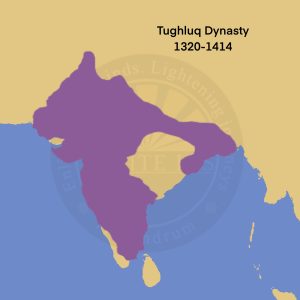Tughlaq Dynasty

Ghiyas-ud-din Tughlaq (1320-25 CE)
- The Tughlaq dynasty was founded by Ghiyas-ud-din Tughlaq, also known as Ghazi Malik.
- He built the famous Tughlaqabad Fort in Delhi,
- During his reign, he enhanced postal service, transportation, and communication.
- Dawk chowkies were established and men were swapped out for horses in the courier system.
- He subdued Bengal and Warangal.
- Following the accident that killed Ghiyas-ud-din Tughlaq, his son Muhammad bin Tughlaq inherited the kingdom.
Muhammad Bin Tughlaq (1325-51 CE)
- He defeated the Mongols.
- Appointed officer in the Delhi Sultanate based on merit.
- He was an accomplished Arabic and Persian scholar who showed religious tolerance.
- Moroccan-born Ibn-Batuta was Muhammad Bin Tughlaq’s contemporary.
- Muhammad Bin Tughlaq constructed the city of Jahanpanah and the Adilabad fort.
- Three significant South Indian kingdoms- Vijayanagar, Bahamani, and Madurai- rose to power during his rule.
- Failed Reforms:
- Capital transfer
- Shifted his capital from Delhi to Deogir in the Deccan and renamed it Daulatabad.
- It was later shifted back to Delhi as a result of many hardships.
- Token Currency
- Introduced Bronze coins or Jittal of the same value as Silver coins (Tanka) to overcome the shortage of silver in India.
- But Folks started creating token money in their homes. Large quantities of counterfeit and duplicate coins entered the market.
- As a result, bronze coins lost a great deal of value and were rejected by the public, which further reduced trade.
- Finally, the government was compelled to withdraw the bronze Jittal coins and replace them with Tanka, gold, and silver pieces.
- Khorasan Expedition
- Muhammad Bin Tughlaq’s divisive endeavor, the Khorasan expedition, was undertaken in 1330–1331 CE.
- A sizable force was gathered by Muhammad Bin Tughlaq for the invasion of the Khorasan region.
- It is believed that after amicable relations were formed between Muhammad bin Tughlaq and Tarmashirin, the Khorasan mission was canceled.
- Capital transfer
- Other Reforms:
- Agriculture Reform
- Provided agricultural loan ‘Takavi’ to farmers.
- Created the “Diwan-i-Kohi” (Department of Agriculture)
- He appointed Amir-i-kohi (the minister of agriculture)
- Agriculture Reform
Feroz Shah Tughlaq (1351-88 CE)
- Following Muhammad bin Tughlaq’s passing, Firoz Shah Tughlaq succeeded to the throne.
- Religiously intolerant ruler – He destroyed many Hindu temples and Jaziya was enforced.
- However, he preserved and translated many Sanskrit texts into Persian.
- He established water cess haq-i-shrub, connected rivers, and used four canals to create irrigation. Also introduced an irrigation tax ( Haqq-i-Sharb).
- He established the Diwan-i-Khairat, the office for charitable work, and the Diwan-i-Bundagan, the Department of Slaves, he constructed numerous parks and canals.
- He founded four new towns, hospitals known as Darul-Shifa, Bimaristan, or Shifa Khana, adopted the Iqtadari framework, and erected Sarais for the convenience of travelers and traders.
- He was called the Sultan of Structures as a result of all of these.
- Muhammad Shah succeeded to the throne after Firoz Shah died in 1388.
Nasiruddin Muhammad (1390-1398 CE)
- The Tughlaq dynasty came to an end under his leadership.
- The Delhi Sultanate was weakened by Taimur’s invasion in 1398. Taimur faced no opposition from the Indian side. Later in 1399, he left India.
- The Delhi Sultanate collapsed at the start of the fifteenth century. 1412 marked the fall of the Tughlaq empire.
Tughlaq – Art and Architecture
- Tughlaq rulers like Ghiyasuddin Tughlaq and Muhammad-bin-Tughlaq contributed to the growth of the culture in India.
Literature
- The Persian translation of Ragadarpan, an Indian traditional text on music, was initiated by Firoz Shah.
- They encouraged the development of calligraphy, poetry, and literature.
- Academics and poets like Ibn Battuta and Amir Khusrau were popular at the Tughlaq courts.
- For instance, Firoz Shah’s patronage of the following notable scholars: Tughlaq Namah (a chronicle of the Tughlaq dynasty) by Ziauddin Barani Tarikh-i-Firuz Shahi – Shams-i-Siraj Afif (a chronicle of Firoz Shah).
Architecture
- Huge palace-forester complexes were constructed at Tughlaqabad by the Tughalqs.
- The buildings saw combined features from several architectural traditions, including Persian, Central Asian, and Indian.
- Tughlaqabad Fort (Delhi)
- Built by Ghiyasuddin Tughlaq.
- The fort’s enormous stone walls, bastions, and entrances demonstrate the Tughlaq emperors’ mastery of military architecture.
- To spruce up the nation’s capital, two Ashokan pillars were transported to Ambala from Meerut and Topara by Firoz Shah
- Firoz Shah Kotla is designed by Firoz Shah Tughlaq located at Delhi.
- The complex consists of multiple buildings, such as the Ashokan Pillar, a palace, and a mosque.
- Jahanpanah: Meaning “Refuge of the World,” this planned city was established by Muhammad bin Tughlaq and acted as the fourth city of Delhi during the Tughlaq era.
- The Tughlaq dynasty contributed to the building of the tomb architecture.
